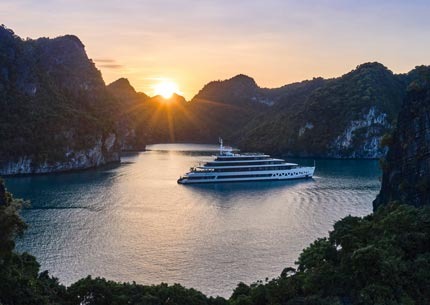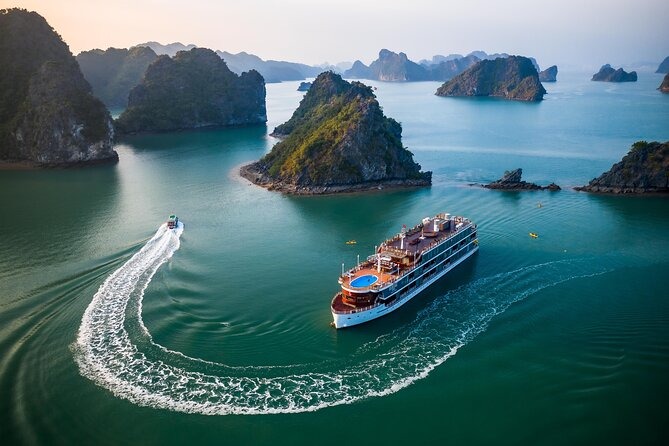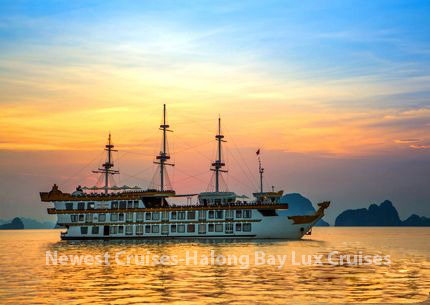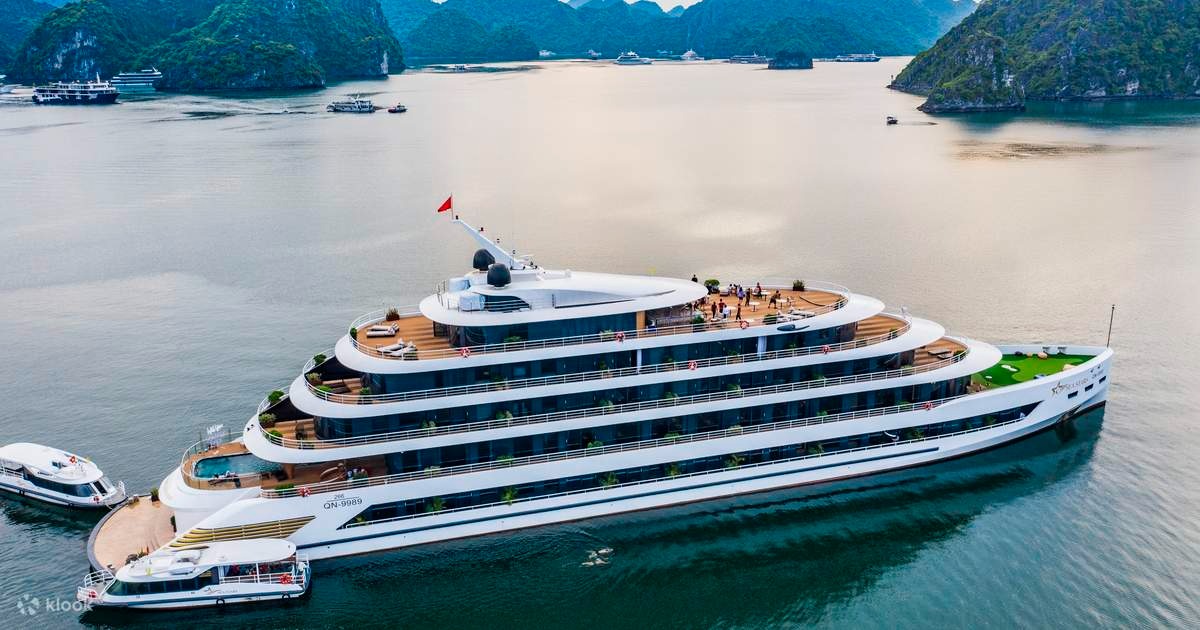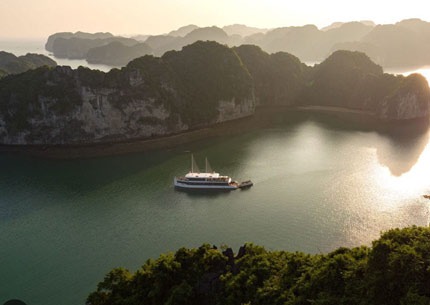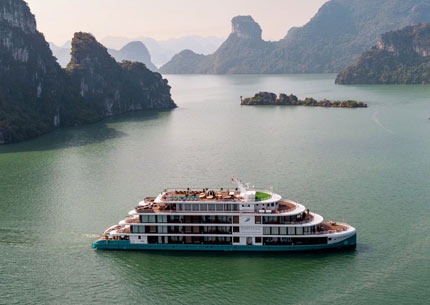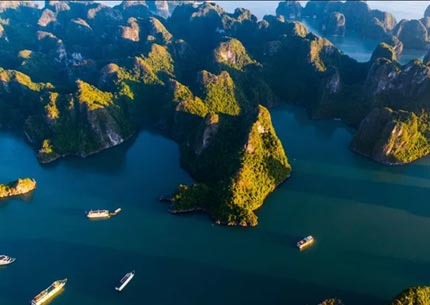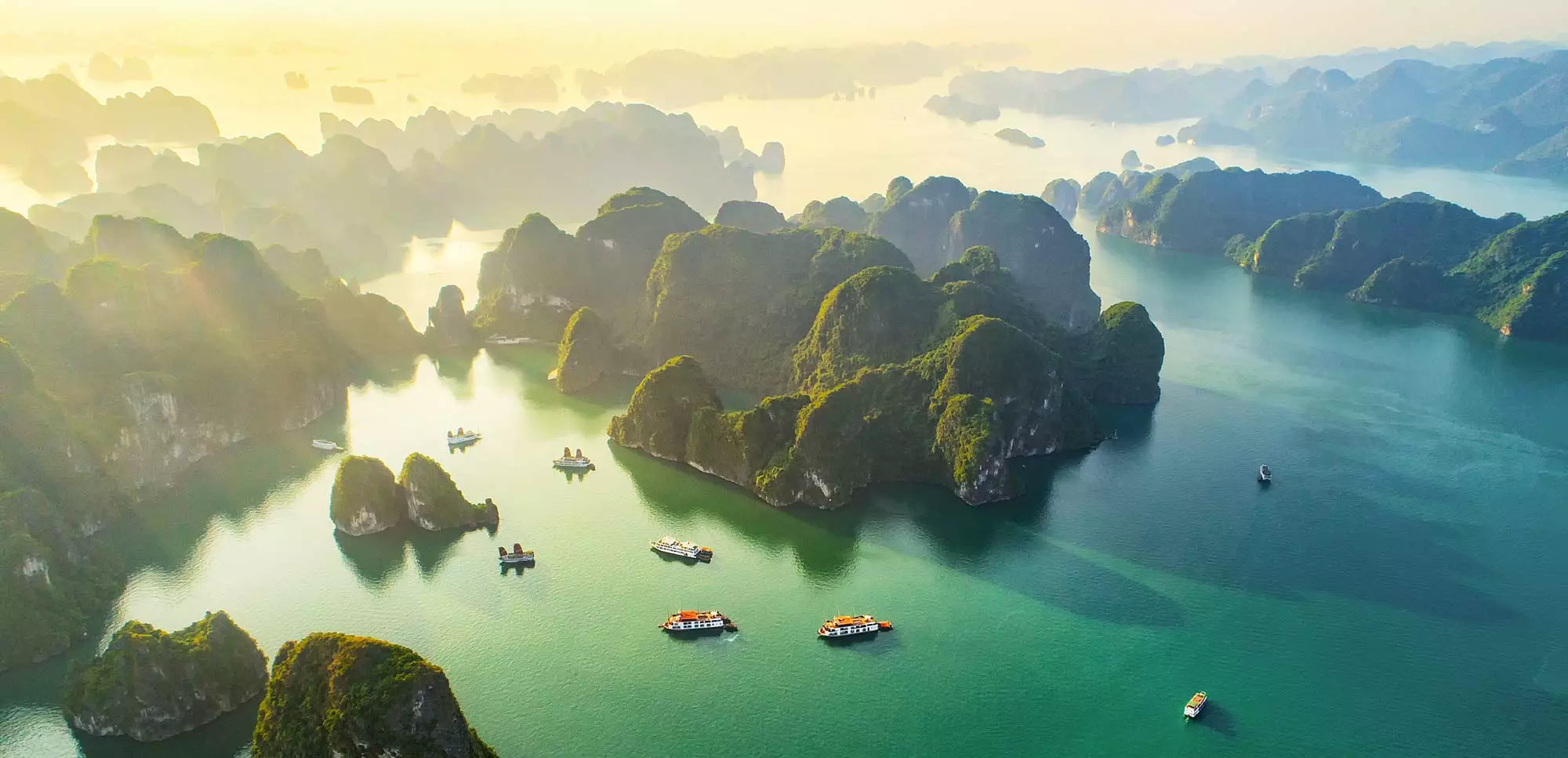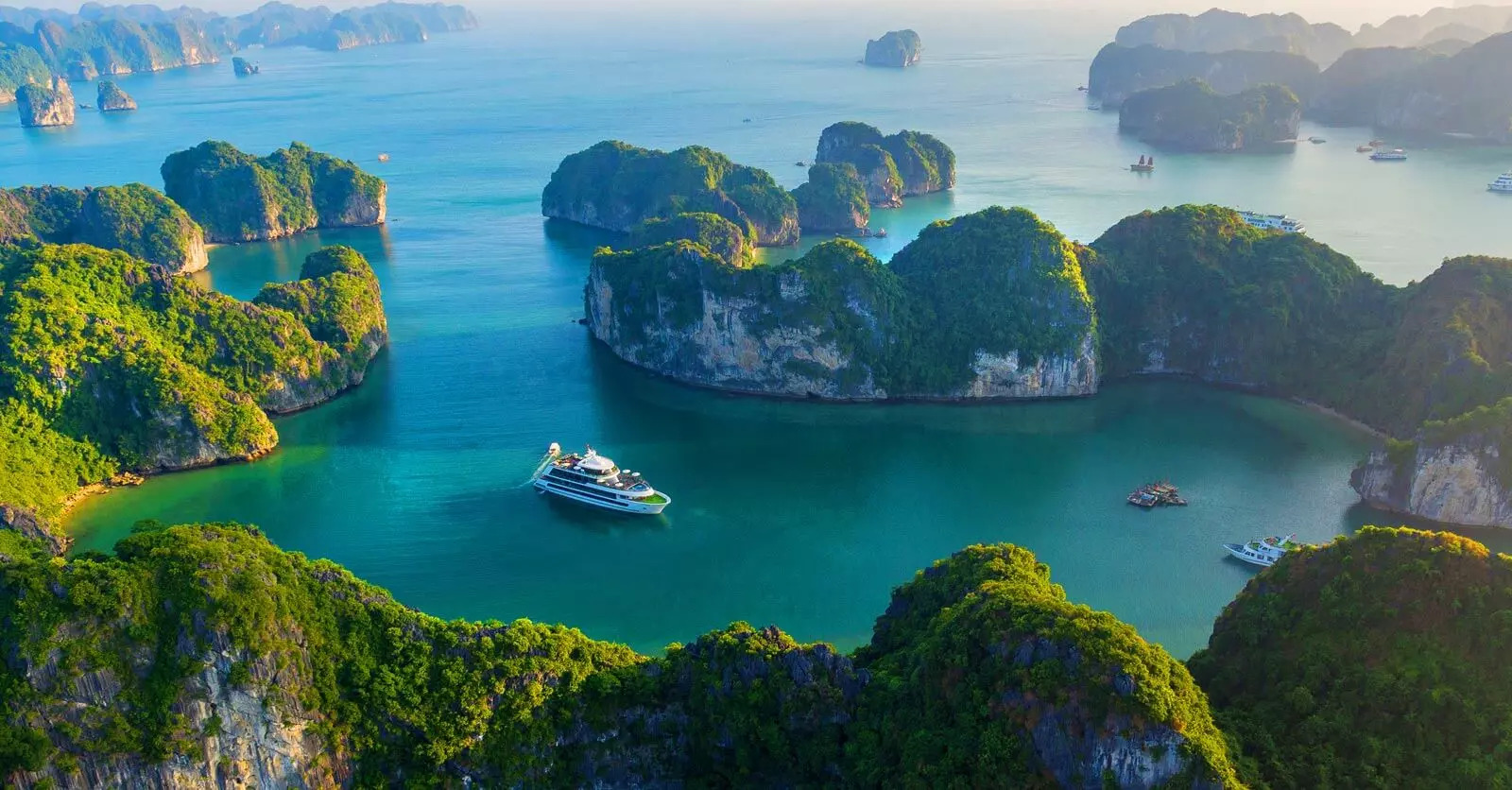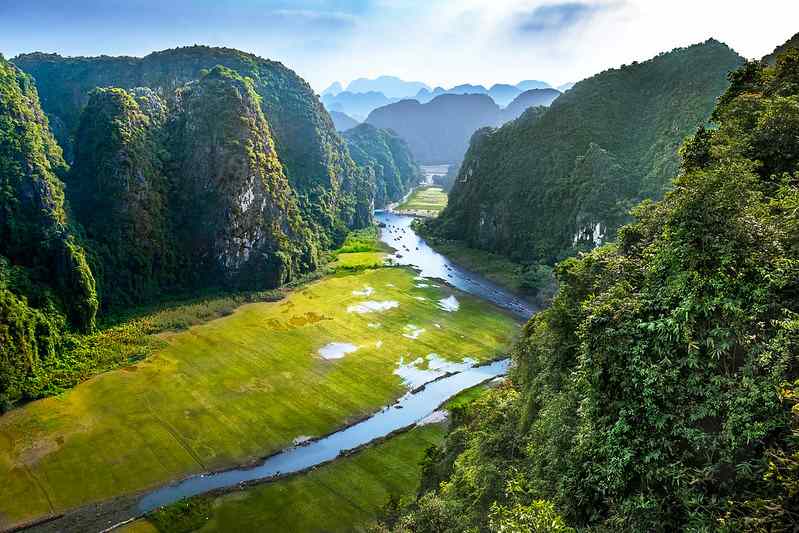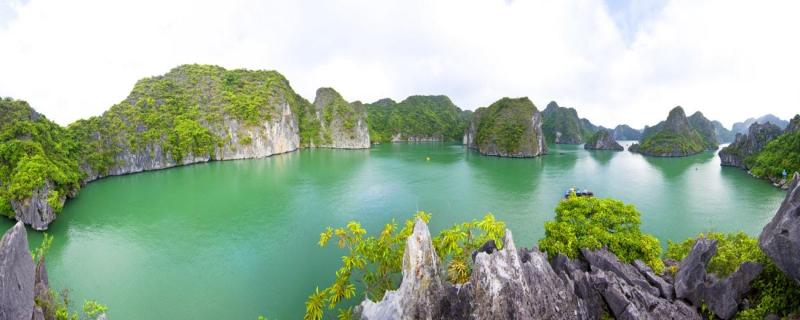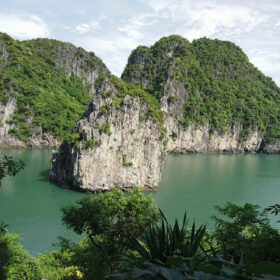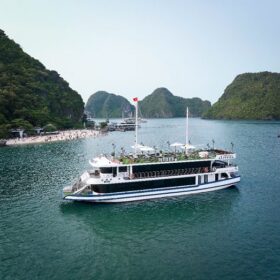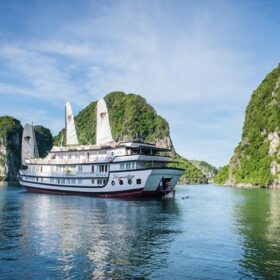Top 15 Reasons to Visit Bai Tu Long Bay in Winter 2025-2027: The Ultimate Seasonal Guide
Bai Tu Long Bay, the serene sister of the famous Ha Long Bay, transforms into a mystical paradise in winter. Fog gently embraces the limestone karsts, creating a dreamlike atmosphere. With fewer tourists, the bay offers a peaceful experience that summer visitors often miss. This comprehensive guide reveals everything you need to know about exploring this UNESCO World Heritage site during its most enchanting season.
The Magic of Bai Tu Long Bay’s Winter Climate (November-February)
Winter transforms Bai Tu Long Bay into a dramatically different landscape. From November to February, a mystical ambiance settles over the bay as morning mists drift across its 1,600+ limestone islands.
Temperatures range from 14°C to 26°C (57°F to 78°F), offering cool but comfortable weather ideal for kayaking, hiking, and photography. Unlike summer, there’s no intense heat or humidity.
Meteorological data for 2025–2027 shows that December and January will be the driest months, with only 40–60mm of rain—far less than summer’s 250–300mm. Expect clear skies around 70% of the time, perfect for sightseeing and photos.
Sea conditions are also calmer in winter, with wave heights in protected areas rarely exceeding 0.5 meters. This ensures smoother sailing, especially for those sensitive to motion.
For photographers, winter brings soft, diffused light due to the low sun angle and mist. These conditions enhance the bay’s textures and mood in ways summer light cannot.
If you’re planning a visit during the 2025-2027 winter seasons, our luxury cruises are specifically designed to maximize comfort during these cooler months, with heated cabins and panoramic windows that allow you to enjoy the misty winter landscapes while staying cozy.

Why Winter Transforms Bai Tu Long Bay into a Photographer’s Paradise
Winter conditions create a photographer’s dreamscape across Bai Tu Long Bay. The combination of cool air and warm water generates a mystical morning fog that typically lifts between 9-11 AM, revealing dramatic limestone karsts emerging from the mist like ancient sentinels.
Professional photographers consider this season the prime time for landscape photography in northern Vietnam, with the soft, diffused light creating depth and dimension impossible to capture during other seasons. The fog adds a painterly quality to images, transforming ordinary scenes into ethereal landscapes worthy of fine art galleries.
During the 2025-2027 winter seasons, photographers can expect approximately 3-4 hours of golden and blue hour light each day—significantly longer than in summer.
This extended magic-hour lighting provides more photographic opportunities at key locations. Popular spots include Thien Canh Son Cave and Vung Vieng Fishing Village.
During winter, sunrises occur around 6:30 AM and sunsets around 5:30 PM. These times are more convenient for cruise passengers. They allow you to capture golden-hour moments without disrupting the standard cruise schedule.
Many luxury vessels adjust their itineraries specifically to take advantage of these photographic opportunities in winter.
For serious photographers, bringing a tripod is highly recommended for low-light dawn shots. A polarizing filter can help reduce glare on the water. A zoom lens in the 24–70mm range is typically the most versatile for capturing both wide bay scenes and close-up details of distant limestone karsts.
15 Essential Winter Activities in Bai Tu Long Bay You Can’t Miss
1. Kayaking Through Misty Morning Waters
Winter kayaking in Bai Tu Long Bay offers a surreal experience as you glide through calm waters surrounded by mystical morning fog. Between 7-9 AM, the visibility often extends just 50-100 meters, creating intimate encounters with the limestone formations that suddenly appear before you. The temperature of the water remains a relatively comfortable 18-22°C (64-72°F) even in winter, making brief hand contact pleasant during paddling.
The reduced tourist numbers mean you’ll often have entire lagoons and hidden coves to yourself—places that would be crowded with dozens of kayaks during peak summer months. Winter kayakers frequently report peaceful encounters with local wildlife, including the rare white-headed langur monkeys that sometimes appear on the rocky cliffs in the early morning hours.
For the 2025-2027 winter seasons, many cruise operators have introduced specialized transparent kayaks that allow you to observe the underwater ecosystem while staying dry and comfortable in the cooler air. These provide exceptional views of the bay’s thriving coral systems, which maintain approximately 75% clarity during winter months compared to summer’s often murky waters.
2. Exploring Thien Canh Son Cave Without the Crowds
Winter transforms the popular Thien Canh Son Cave into a private wonderland. During summer months, this spectacular limestone cave receives upwards of 800-1,000 daily visitors, creating lines and crowded viewing platforms. In winter, these numbers drop dramatically to fewer than 200 visitors per day, allowing for a more intimate exploration.
The cave’s interior maintains a constant temperature of approximately 20-22°C (68-72°F) year-round, making it a comfortable retreat from cooler winter air outside. The reduced humidity of winter (typically 65-75% versus summer’s 85-95%) also enhances visibility of the cave’s intricate stalactite formations, some of which have been developing for over 500,000 years.
Winter lighting within the cave creates dramatic shadow effects not visible during other seasons. The lower angle of winter sunlight penetrates deeper into the cave entrance, illuminating the 12-meter-high central chamber with golden rays between 10 AM and 2 PM—a photographer’s dream that simply doesn’t occur during summer months.
Many 3-day cruise itineraries include extended time at this cave during winter, allowing guests to fully appreciate its geological wonders without feeling rushed.
3. Authentic Cultural Exchanges at Vung Vieng Fishing Village
Winter visits to Vung Vieng Fishing Village offer genuine cultural immersion impossible during busier seasons. This floating community of approximately 50 households (about 200 residents) welcomes visitors differently during winter months. With fewer tourists passing through, village families often invite guests to join in traditional activities rather than simply demonstrating them.
During December and January, village fishermen harvest pearl oysters that have been cultivating throughout the year. Visitors can participate in the pearl grading process, learning how locals determine quality based on luster, size, and color. The winter harvest typically yields pearls ranging from 2-10mm in diameter, with the most valuable being the rare golden pearls unique to this region.
The village school, which serves approximately 25-30 children from the floating community, often welcomes winter visitors to interact with students during their English lessons. This mutually beneficial exchange gives travelers authentic insight into local life while providing students valuable practice with native English speakers.
Many winter cruises arrange special cooking demonstrations with village families, where you’ll learn to prepare traditional Vietnamese dishes using freshly caught seafood from the bay. The cooler winter temperatures make these cooking experiences much more comfortable than in summer’s oppressive heat.
4. Savoring Seasonal Winter Seafood Delicacies
Winter brings a special harvest from Bai Tu Long Bay’s waters that summer visitors never experience. The cooler water temperatures trigger spawning seasons for several premium seafood varieties, making winter the prime season for culinary exploration.
From November through February, the bay’s famous Vân Đồn oysters reach their peak flavor profile, with fat content increasing by approximately 30% compared to summer months. These prized bivalves, measuring 8-12cm in length, offer a distinctly sweet, mineral-rich flavor unique to the bay’s limestone-filtered waters.
Winter is also the only season to enjoy Hạ Long King Crab (Cua Hoàng Đế), a regional delicacy available from December through February. These impressive crustaceans, weighing between 1.5-2.5kg each, are typically prepared in simple garlic and butter sauces to highlight their naturally sweet meat.
For the 2025-2027 winter seasons, several premium cruise lines have partnered with local fishing communities to offer exclusive seafood-focused dinner experiences featuring the day’s fresh catch prepared according to traditional family recipes passed down through generations.
The bay’s famous tiger prawns also reach their largest size during winter months, growing to an impressive 18-22cm in length with sweeter, firmer flesh than their summer counterparts. These are often served with minimal preparation—simply grilled with local herbs to preserve their delicate flavor.
5. Winter Wildlife Spotting Opportunities
Winter transforms Bai Tu Long Bay into a prime wildlife viewing destination, with several species becoming more visible during the cooler months. The bay serves as an important winter refuge for migratory birds, hosting over 60 different species that aren’t present during summer months.
Birdwatchers should keep their binoculars ready for the striking black-faced spoonbills and eastern egrets that frequent the shallow waters between limestone karsts from November through February. These migratory visitors, traveling from as far as Siberia, can often be spotted in groups of 5-30 birds during early morning hours.
Marine life also becomes more visible during winter due to improved water clarity. The bay’s indo-pacific humpback dolphins, a critically endangered species with fewer than 100 individuals remaining in Vietnamese waters, are spotted more frequently during winter months when they follow fish populations into the deeper channels of the bay.
Winter’s cooler temperatures bring reptiles like the Cat Ba langur (one of the world’s most endangered primates with only about 70 individuals remaining) down from higher elevations. Though still rare, winter sightings occur more frequently, particularly around dawn near the borders of Bai Tu Long National Park.
For marine enthusiasts, the winter months reveal thriving coral gardens normally obscured by summer’s stirred-up sediment. In areas like Cong Do, underwater visibility increases to 8-12 meters compared to summer’s 3-5 meters, allowing snorkelers to observe the bay’s over 160 species of coral and 500+ species of fish.
6. Exclusive Access to Remote Islands
Winter delivers exclusive access to several remarkable islands that remain off-limits during stormy summer months. The calmer winter seas allow cruise captains to safely navigate to remote locations like Cong Do Island, home to a pristine 800-meter white sand beach that’s inaccessible approximately 40% of the year due to rough waters.
The dramatic Ba Mun Island, with its 13 sq km of primary forest, becomes safely accessible during winter. This protected nature reserve hosts some of Vietnam’s most endangered species, including the clouded leopard and the rare Vietnamese salamander, which are more active in the cooler temperatures.
Winter visitors to these remote islands often experience complete solitude, with visitor numbers dropping to fewer than 20 people per day on some of the more distant islets—compared to hundreds during peak season. This creates unparalleled opportunities for nature immersion and photography without human elements in frame.
For the 2025-2027 winter seasons, special permits have been arranged for access to Tra Bau Island, previously restricted to researchers only. This island features a unique freshwater lake in its center surrounded by limestone cliffs, creating a mesmerizing inland ecosystem distinct from the marine environment.
Several 2-day cruise itineraries have been specifically designed to take advantage of these winter-exclusive destinations, offering experiences that summer visitors simply cannot access regardless of budget.
7. Magical Sunrise and Sunset Experiences
Winter’s atmospheric conditions create extraordinary light shows at dawn and dusk across Bai Tu Long Bay. The combination of cool air, warm water, and winter light angles produces spectacularly vivid color palettes that photographers chase year after year.
Winter sunrises typically feature an ethereal quality as first light illuminates the morning mist, creating what locals call “dragon’s breath” as it swirls around the limestone peaks. The optimal viewing time occurs between 6:15-6:45 AM, when the eastern sky transforms through a remarkable spectrum of colors from deep purple to brilliant orange.
Winter sunsets benefit from the season’s typically clearer air, allowing for sharper definition of the limestone silhouettes against the evening sky. The winter sun sets around 5:30 PM, casting long shadows across the bay and creating dramatic contrast between illuminated and shadowed faces of the karst formations.
For the 2025-2027 winter seasons, several premium cruise operators have introduced dedicated sunrise yoga sessions on their top decks, allowing guests to greet the day with mindful movement as the mystical landscape gradually reveals itself from darkness.
The best sunset viewing points include the western side of Quan Lan Island and the elevated observation deck at Thien Canh Son Cave, both of which provide unobstructed 180-degree views across the bay. During winter, these locations often experience what photographers call “alpenglow“—a phenomenon where the limestone peaks briefly glow pink after the sun has already dipped below the horizon.
8. Traditional Winter Celebrations and Festivals
Winter coincides with several of Vietnam’s most significant cultural celebrations, adding a festive dimension to Bai Tu Long Bay cruises. Travelers visiting between December and February might encounter vibrant local traditions rarely witnessed by summer tourists.
The Vietnamese Lunar New Year (Tết) typically falls in late January or early February, transforming coastal communities around the bay. Local fishing villages adorn their boats and homes with red and gold decorations, and many cruise lines incorporate special Tết activities into their winter itineraries, including traditional calligraphy lessons and fortune telling ceremonies.
December visitors might experience the Winter Solstice Festival (Đông Chí), when local families prepare special pink sticky rice balls called “bánh trôi” that symbolize family unity. Several cruise operators arrange for guests to participate in making these traditional treats alongside local families.
The Lê Hội Ông Công Ông Táo (Kitchen God Festival) occurs in late January, approximately one week before Tết. This unique celebration involves releasing small carp into the bay waters to transport the Kitchen God to heaven. Winter visitors can participate in this charming ritual alongside local families who prepare elaborate paper offerings to accompany the fish.
For the 2025-2027 winter seasons, several community-based tourism initiatives have developed exclusive cultural exchanges where visitors can learn traditional crafts like lantern making and water puppet carving from master artisans in villages surrounding the bay.
9. Winter Cave Explorations Beyond the Tourist Trail
Winter’s reduced tourist numbers enable access to several remarkable caves that remain off-limits during crowded summer months. These lesser-known caverns offer intimate experiences with some of the bay’s most spectacular geological formations.
Hang Luon Cave, accessible only by small boat or kayak through a 4-meter-high natural stone arch, leads to a secluded 8,000-square-meter interior lagoon surrounded by sheer limestone walls rising 100+ meters on all sides. During winter, the cave’s waters become remarkably clear, with visibility extending to 7-9 meters compared to summer’s 2-3 meters.
The rarely visited Hang Tiên Ông (Fairy Cave) preserves ancient stalactites formed over approximately 300,000 years. Winter’s lower humidity (typically 65-75% versus summer’s 85-95%) significantly enhances visibility of the cave’s delicate formations, some as thin as a human hair and extending up to 2 meters in length.
For adventure seekers, winter permits exploration of Hang Sửng Sốt (Surprise Cave) with its massive 10,000-square-meter main chamber capable of holding over 1,000 people. The cave maintains a constant year-round temperature of approximately 20-22°C, making it a comfortable retreat from cooler winter air while providing spectacular views of formations illuminated by specialized lighting systems.
Several cruise operators offer exclusive early-morning access to these caves during winter months, allowing guests to experience these natural wonders before they open to general visitors. This private viewing time creates opportunities for unobstructed photography and quiet contemplation impossible during busier periods.
10. Luxury Winter Cruise Experiences with Exclusive Amenities
Winter transforms the cruising experience in Bai Tu Long Bay, with luxury vessels offering special amenities designed specifically for the cooler season. From November through February, premium cruise lines enhance onboard comfort with seasonal adjustments that create cozy, intimate atmospheres.
Many luxury vessels feature heated pools and outdoor jacuzzis maintained at approximately 38-40°C (100-104°F), allowing guests to soak while enjoying the misty winter landscapes. The contrast between the warm water and cool air creates a magical sensory experience unique to winter cruising.
Evening entertainment moves indoors to specially designed winter lounges with panoramic windows spanning 180-220 degrees of viewing angle, ensuring you don’t miss the spectacular sunsets while staying comfortable. Many vessels arrange traditional Vietnamese tea ceremonies during sunset hours, pairing local teas with seasonal delicacies.
For the 2025-2027 winter seasons, several top-tier cruise operators have introduced in-cabin massage services featuring warming treatments like hot stone therapy and ginger compresses—perfect for relaxing after a day of winter exploration. These treatments utilize locally sourced ingredients including cinnamon and star anise harvested from Vietnam’s northern mountains.
Winter dining experiences often feature special seasonal menus highlighting hearty Vietnamese soups and hotpot dishes that showcase the bay’s winter seafood harvest. Many vessels offer cooking demonstrations where chefs prepare traditional winter favorites like cháo hàu (oyster congee) and lẩu hải sản (seafood hotpot).
The finest vessels arrange private candlelit dinners in secluded coves, where the cool winter air enhances the intimacy of the experience while panoramic views of mist-shrouded limestone karsts create an unforgettable backdrop.
11. Winter Hiking and Nature Trails
Winter’s mild temperatures make hiking in Bai Tu Long National Park considerably more comfortable than during summer’s intense heat and humidity. Several remarkable trails become accessible during this season, offering breathtaking views and unique ecological encounters.
The Ban Chan Trail on Quan Lan Island spans approximately 5.7 kilometers through diverse ecosystems including primary forest and coastal viewpoints. Winter hikers benefit from temperatures averaging **18-24°C (64-75°F)**—ideal conditions for the moderate elevation gains of up to 320 meters along certain sections of the trail.
For serious nature enthusiasts, the Bai Tu Long National Park Research Trail opens exclusively during winter months (December-February). This guided hike covers 8.3 kilometers through protected forest where researchers study the bay’s endemic plant species. The trail provides opportunities to observe over 620 plant species and 200 animal species, many of which are more active during the cooler season.
The Thien Canh Son Summit Trail offers the bay’s most spectacular panoramic views from its 218-meter summit. During winter, visibility from this vantage point typically extends 15-20 kilometers on clear days, allowing hikers to appreciate the full scale of this UNESCO World Heritage landscape. The trail covers 3.2 kilometers round-trip with several stepped sections requiring moderate fitness.
Winter hiking in the region benefits from significantly reduced insect activity, with mosquito populations dropping by approximately 80-90% compared to summer months. This makes outdoor exploration much more comfortable, especially during dawn and dusk hours when wildlife is most active.
Several cruise operators offer specialized hiking packages during winter months, providing professional guides, appropriate gear, and packed meals for full-day exploration of these remarkable trails.
12. Winter Stargazing Opportunities
Winter offers the best stargazing conditions of the year in Bai Tu Long Bay. Clear skies and reduced light pollution create ideal celestial viewing opportunities. The bay’s remote location already provides darker skies than nearby urban areas. Winter’s lower humidity further enhances astronomical visibility.
December through February offers approximately 5-7 nights per month with optimal stargazing conditions—defined as clear skies with humidity below 70% and minimal moonlight. During these prime viewing periods, observers can typically identify 2,500-3,000 individual stars with the naked eye, compared to just a few hundred visible from urban areas.
The winter night sky showcases several prominent constellations not visible during summer months, including Orion, Taurus, and the Pleiades star cluster. These northern hemisphere winter constellations appear particularly vivid when viewed from the bay’s dark waters between 8 PM and midnight.
For the 2025-2027 winter seasons, several premium cruise operators have partnered with astronomy experts to offer dedicated stargazing excursions on their top decks. These guided sessions utilize professional-grade telescopes with magnification powers of 80-120x, allowing guests to observe distant celestial objects including Saturn’s rings and Jupiter’s major moons.
The combination of cool, clear winter air and minimal light pollution creates ideal conditions for astrophotography. Many vessels now offer specialized camera mounting equipment for night sky photography, enabling even amateur photographers to capture stunning images of the Milky Way arching over the bay’s distinctive limestone karsts.
13. Winter Spa and Wellness Retreats
The winter season brings specialized wellness experiences to Bai Tu Long Bay, with many cruise operators enhancing their spa offerings to align with traditional Vietnamese winter wellness practices. These seasonal treatments utilize warming ingredients specifically selected to balance the body during cooler months.
Several luxury vessels now feature private spa cabins with panoramic bay views, allowing guests to enjoy therapeutic treatments while watching mist drift among the limestone karsts. These specialized wellness spaces typically maintain temperatures of 25-28°C (77-82°F) regardless of outside conditions, creating comfortable environments for longer treatment sessions.
Traditional Vietnamese winter spa treatments incorporate warming elements like ginger, cinnamon, and star anise—ingredients believed to stimulate circulation and boost immunity during colder months. Signature winter offerings include hot stone massages using basalt stones harvested from volcanic regions of central Vietnam, heated to precisely 50-55°C (122-131°F) to release muscle tension.
For the 2025-2027 winter seasons, several premium vessels have introduced floating meditation platforms anchored in secluded coves, where guests can practice guided mindfulness sessions while gently rocking with the bay’s calm winter waters. These 60-90 minute sessions take place at sunset when the changing light creates a naturally meditative atmosphere.
Many cruise operators now arrange early morning tai chi sessions on their sun decks, timed to coincide with winter sunrise between 6:15-6:45 AM. These gentle movement practices are led by certified instructors and modified to accommodate all fitness levels, providing an energizing start to winter days exploring the bay.
The finest vessels offer full-day wellness journeys that integrate multiple holistic practices with the winter landscape, including forest bathing on isolated islands, sound healing in echo-enhancing caves, and nutrition workshops featuring immune-boosting local ingredients.
14. Winter Photography Workshops and Tours
Winter’s unique atmospheric conditions make Bai Tu Long Bay a photographer’s paradise. Many cruise operators now offer specialized photography programs during these months. These workshops cater to all skill levels, from smartphone enthusiasts to professional DSLR users.
Several premium vessels feature dedicated photography guides. These experts have intimate knowledge of how winter light interacts with the bay’s landscape. They lead daily excursions to locations specifically chosen for their winter photographic potential. Highlights include misty morning kayak trips designed to capture the dramatic emergence of limestone karsts from the fog.
For serious photographers, some cruises offer drone photography workshops. These sessions cover both technical skills and ethical considerations when capturing aerial imagery of this protected landscape. Guided flights typically take place in designated drone zones that offer spectacular vantage points while complying with environmental regulations.
The lower number of tourists in winter creates excellent conditions for long-exposure photography. Photographers can capture popular sites without unwanted human elements in the frame. Photography-focused itineraries often include extended stops, allowing time to wait for ideal lighting rather than rushing to the next destination.
For the 2025–2027 winter seasons, several operators have introduced night photography excursions. These experiences use specialized low-light equipment to capture the bay’s limestone silhouettes against star-filled skies. Some also offer creative sessions with light-painting techniques using traditional Vietnamese lanterns.
Many vessels now offer onboard editing workshops each evening, where photography guides provide personalized instruction on post-processing techniques specifically suited to the challenging lighting conditions of winter in the bay. These sessions utilize professional-grade editing software and high-caliber monitors calibrated for accurate color representation.
15. Exclusive Winter Cooking Classes and Culinary Experiences
Winter in Bai Tu Long Bay brings distinctive seasonal ingredients and traditional cooking methods that showcase northern Vietnam’s culinary heritage. Many cruise operators have developed specialized culinary programs that allow guests to explore these winter food traditions through hands-on experiences.
Several luxury vessels offer market-to-table experiences where guests visit local winter markets in port towns like Cái Rồng, where approximately 40-50 vendors gather each morning to sell seasonal specialties. Winter markets feature distinctive ingredients not available in summer, including mountain mushrooms, northern herbs, and winter melons harvested from villages surrounding the bay.
Onboard cooking classes focus on traditional winter dishes like cháo cá (fish congee), canh chua (sour soup), and bánh trôi tàu (sweet dumplings in ginger syrup)—all foods designed to provide warmth and comfort during cooler months. These 60-90 minute classes typically accommodate 8-12 participants to ensure personalized instruction from the vessel’s head chef.
For the 2025-2027 winter seasons, several premium cruise lines have partnered with renowned Vietnamese chefs to offer exclusive culinary journeys focusing on northern Vietnam’s winter cuisine. These specialized voyages include master classes in techniques like clay pot cooking and steam basket preparation—methods particularly suited to winter dishes.
The most luxurious vessels arrange private beach dining experiences where chefs prepare traditional winter hotpot meals on secluded shores. These intimate dinners feature ingredients sourced that very day from local fishing villages, including seasonal seafood harvested from the bay’s winter waters.
Many operators now offer food photography workshops specifically designed to capture the vibrant colors and textures of Vietnamese winter cuisine. These sessions combine culinary and photography instruction, teaching guests to document their food journey through Vietnam with professional-quality images.
Essential Packing List for Winter Bai Tu Long Bay Cruises
Preparing appropriately for winter in Bai Tu Long Bay ensures your comfort throughout your journey. While temperatures rarely drop below 14°C (57°F), the combination of humidity and sea breezes can make evenings feel cooler than the thermometer suggests.
For daytime exploration, pack lightweight, quick-drying layers that can be adjusted as temperatures fluctuate throughout the day. A waterproof or water-resistant jacket is essential for kayaking excursions and potential light rain showers, particularly in November and February which bookend the drier central winter months.
Evening temperatures typically range from 14-18°C (57-64°F), making a medium-weight sweater or fleece appropriate for sunset viewing and nighttime activities on deck. While heavy winter clothing is unnecessary, light gloves and a beanie can be comfortable additions for early morning activities when temperatures are at their lowest.
Footwear should include non-slip shoes or sandals for onboard use and closed walking shoes for cave explorations and island hikes. Many caves and trails remain slightly damp year-round, so water-resistant hiking shoes are ideal if you plan extensive exploration.
For photography enthusiasts, bringing a tripod is highly recommended for low-light conditions during sunrise, sunset, and potential night photography. A polarizing filter will help manage glare from the water, particularly valuable during winter when the lower sun angle can create challenging reflections.
Don’t forget to pack sunscreen (minimum SPF 30) despite the cooler temperatures—the winter sun can still cause sunburn, especially when reflected off water surfaces. A wide-brimmed hat provides important sun protection during daytime excursions.
Many cruise operators provide complimentary warm blankets for outdoor lounging during evenings, but bringing a light scarf or shawl offers versatility for adjusting to changing temperatures throughout the day and evening.
How to Choose the Perfect Winter Cruise in Bai Tu Long Bay
Selecting the right cruise experience for winter exploration of Bai Tu Long Bay requires consideration of several factors beyond basic price points. The winter experience varies significantly depending on vessel type, itinerary length, and onboard amenities.
For optimal winter comfort, prioritize vessels with climate-controlled cabins that maintain temperatures between 22-25°C (72-77°F) regardless of outside conditions. The finest winter cruise options feature heated bathroom floors and individual temperature controls in each cabin—details that significantly enhance comfort during cooler evenings.
Itinerary length becomes particularly important during winter months. While 1-day cruises offer a brief introduction to the bay, the reduced daylight hours of winter (approximately 11 hours versus summer’s 13-14 hours) make 2-day or 3-day itineraries significantly more rewarding. These longer journeys allow for exploration of more remote areas and provide flexibility to adjust activities around winter weather patterns.
When reviewing cruises, look for winter-specific features. Heated pools, covered decks, and indoor lounges with wide views are ideal. These amenities keep you comfortable while enjoying the scenery.
If you’re into photography, ask about winter photo tours. The best cruises time them around sunrise and sunset. These moments reveal the bay’s misty, dramatic beauty.
Choose smaller ships with 8–16 cabins. They offer better service and flexibility in winter. They can also reach secluded spots that big ships can’t.
Smaller boats adapt more easily to changing weather. In 2025–2027, some cruises have special winter itineraries. These aren’t just summer tours with tweaks.
They focus on what winter does best—highlighting caves, viewpoints, and calm areas. These routes avoid long stretches in cold, open waters.
Practical Winter Travel Tips for Bai Tu Long Bay Visitors
Transportation and Arrival Recommendations
Winter travel to Bai Tu Long Bay benefits from more reliable transportation schedules compared to summer’s occasional weather disruptions. Most visitors arrive via Hanoi, where international flights connect to Van Don International Airport (approximately 50km from the bay’s main harbors).
For the 2025-2027 winter seasons, new express shuttles operate between Hanoi and the cruise departure points, covering the 165km journey in approximately 3-3.5 hours depending on traffic conditions. These luxury shuttles feature onboard WiFi, adjustable heating, and reclining seats for maximum comfort during the transfer.
Booking Recommendations and Timing
Luxury cabins with winter perks like heated floors and balconies sell out fast. For better value, travel in early December or late February. Prices can be 15–20% lower, and crowds are smaller. These times still offer great weather and the magical winter atmosphere.
When booking, inquire about winter-specific promotions that many operators offer to encourage tourism during this traditionally slower season. These might include cabin upgrades, complimentary spa treatments, or specialized winter excursions not available to summer visitors.
Health and Safety Considerations
Winter in Bai Tu Long Bay offers healthier conditions with less heat risk, but cooler weather requires preparation. Stay hydrated, as sea air and cabin heating can still cause dehydration—drink 2–3 liters of water daily.
For those prone to motion sickness, winter generally offers calmer sea conditions, with wave heights in the protected bay rarely exceeding 0.5 meters. However, the transitional months (November and February) may occasionally experience stronger northeast monsoon winds. If you’re sensitive to motion, consider packing appropriate medication and selecting a mid-sized vessel (20-30 meters in length) which provides stability without sacrificing maneuverability.
While swimming is possible during winter months, water temperatures averaging 18-22°C (64-72°F) may feel cool to some travelers. Most premium vessels offer heated pools or hot tubs for comfortable water enjoyment regardless of outside conditions.
Conclusion: Why Winter 2025-2027 Is the Ideal Time to Visit Bai Tu Long Bay
Winter transforms Bai Tu Long Bay into a mystical, serene landscape unlike any other season. Fewer tourists and misty mornings create perfect conditions for photography and peaceful exploration. From 2025 to 2027, improved infrastructure and winter-specific cruises enhance the travel experience. Cultural events and calm seas allow access to remote islands not reachable in summer. This is an ideal time to visit before tourism peaks again. Whether for beauty, comfort, or quiet escape, winter offers unforgettable moments in a UNESCO wonder.
Begin planning your winter adventure today with Halong Bay Lux Cruises to secure the optimal experience for your interests, whether that’s a comprehensive 3-day exploration or a focused 2-day journey through this winter wonderland.
Frequently Asked Questions About Winter Visits to Bai Tu Long Bay
What is the absolute best month for a winter visit to Bai Tu Long Bay?
January typically offers the optimal balance of clear skies, calm seas, and atmospheric morning mist that creates the bay’s signature winter landscapes. With average temperatures between 15-20°C (59-68°F) and precipitation averaging just 40mm for the entire month, January provides ideal conditions for photography, kayaking, and outdoor exploration.
Is it too cold to swim in Bai Tu Long Bay during winter?
Water temperatures average 18-22°C (64-72°F) during winter months—cool but not prohibitively cold for brief swimming. Many visitors enjoy short swims during midday hours when air temperatures reach their peak. However, most premium cruise vessels now offer heated pools or jacuzzis maintained at approximately 38°C (100°F) for more comfortable water experiences regardless of season.
How does winter pricing compare to summer for Bai Tu Long Bay cruises?
Winter cruises typically cost 15-25% less than identical summer itineraries outside of the December holiday period and Lunar New Year. This value pricing combined with smaller crowds and unique seasonal experiences makes winter an exceptionally good value for luxury travelers.
Will I miss anything by visiting in winter instead of summer?
Summer is great for swimming and water fun. But winter brings a mystical vibe, clear water, fewer crowds, and unique wildlife. Many photographers and nature lovers prefer winter for its clarity and atmosphere.
How far in advance should I book a winter cruise for 2025-2027?
For standard cabins during most winter periods, booking 2-3 months in advance is typically sufficient. However, for premium cabin categories, holiday periods (December 20-January 5), or Lunar New Year celebrations, reservations should be made 4-6 months ahead to secure your preferred vessel and cabin type.
Hotline | WhatsApp: +84.978.358.422
Phone | WhatsApp: +84.962.261.687
Email: halongbayluxcruises@gmail.com
vietnammarveltravel@gmail.com

